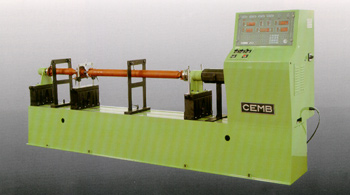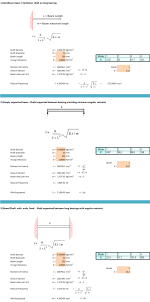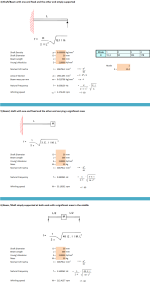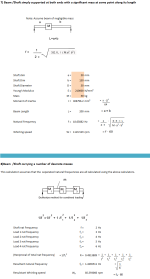Shafts -Natural Frequencies / Whirling speeds

Description
Purpose of Calculation
Simple calculations for obtaining the natural frequency of traverse vibration of shafts and beams which are equal to the shaft whirling speeds.
Calculation Reference
Roymech.co.uk.https://roymech.co.uk/Useful_Tables/Vibrations /Natural_Vibrations.html
Calculation Validation
Background information on the theory is provided on my website Roymech.org
Important Note:Please only enter data in the identified coloured cells.
Introduction
The calculations below are simple calculations to establish the natural frequency of traverse vibration of shafts . It can be easily proved that the naturalfrequency of a shaft is equal to the whirling speed. Whirling is a result of resonance when the shaft rotates at the same speed as one of the shafts natural frequencies of transverse vibration. At this speed the shaft will whirl at an increasing rate . Increasing or reducing the speed will eliminated the whirling effect.
The calculations are all based on the assumption that the beams are round bars of uniform diameter.
The calculations are only for the lower four modes of vibration.
List Of Calcs
- Cantilever beam / Cantilever shaft on long bearing.
- Simply supported beam . Shaft supported between bearing providing minimum angular restraint
- Beam with fixed end . Shaft supported between long bearings with angular restraint.
- Beam / Shaft with one end fixed and the other simply supported
- Beam/ shaft with one end fixed and the other end carrying a significant mass
- Beam /Shaft simply supported at both ends with a significant mass in the middle
- Beam /Shaft simply supported at both ends with a significant mass at some point along its length
8)Beam /Shaft carrying a number of descrete massesCalculation Reference
Mechanical Engineers Data Handbook Carvill Butterworth
Roark's Formulas for Stress and Strain
Vibration Handbook
Calculation Preview
Full download access to any calculation is available to users with a paid or awarded subscription (XLC Pro).
Subscriptions are free to contributors to the site, alternatively they can be purchased.
Click here for information on subscriptions.




